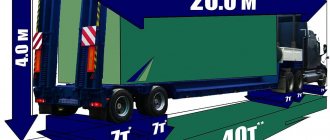Fire, explosion, leakage of radioactive substances - these are the possible damages that can result from improper transportation of dangerous goods. To protect people and the environment, developed countries have developed regulations for the transportation of hazardous substances for all types of transport. In this article we will describe the rules and requirements for the transportation of dangerous goods by land road transport in Russia, consider the main nuances, violations and liability of legal entities for violations.
- What is dangerous goods
- Classes of dangerous goods
- Who has the right to transport dangerous goods?
- Rules for the transportation of dangerous goods by road
- Documents required for the transport of dangerous goods
- Requirements for drivers to transport dangerous goods
- Requirements for vehicles for transportation of dangerous goods
- Permission to drive a vehicle with dangerous cargo
- Violations and fines for incorrect transportation of exhaust gases
- Payment of fines for dangerous goods at a discount
What is dangerous goods
Dangerous cargo is a substance that can harm the health and life of people, the environment and material assets in the event of an accident during its transportation.
The transport of dangerous goods is regulated by the European Agreement concerning the International Carriage of Dangerous Goods by Road (ADR or ADR).
The list of hazardous substances includes more than 3 thousand items. Each such substance has a special identification number. The list is divided into classes.
In Russia, the state standard GOST 19433-88 is in force, which divides dangerous goods into classes according to the level of danger. The requirements of this standard are developed in accordance with ADR.
Classification
The hazardous category includes various materials, waste, and substances that can cause significant harm and damage to the environment, animals, and humans. They are divided into explosive, poisonous, disease-promoting, etc. To simplify the distinction and add specificity to the concept of dangerous cargo, a special classification was developed. According to accepted standards, all dangerous goods are divided into 9 classes. Starting from 1 to 9, these are:
- explosive and explosive various materials;
- compressed, liquefied gases;
- liquids that are highly flammable;
- flammable solids, as well as spontaneously combustible substances that emit extremely dangerous gases that can easily ignite when released into the aquatic environment;
- oxidizing;
- poisonous and infectious;
- cargo with radioactive properties;
- caustic and corrosive;
- others.
Depending on the specific class of dangerous cargo transported by railway, appropriate containers, containers and tanks for their transportation are selected that meet all standards. They are subject to various measures to ensure adequate and effective security. Therefore, the class of cargo is of key importance in the organization of cargo transportation by rail and any other transport. Only competent and professional organization of transportation of dangerous goods by rail makes it possible to prevent emergency and dangerous situations that pose a threat. Therefore, the issue of transportation should be trusted only to those carriers who have special permits, approvals, and also have the material and technical base to organize the delivery of hazardous substances.
Classes of dangerous goods
class 1 - explosive materials; class 2 - compressed, liquefied and dissolved gases under pressure; class 3 - flammable liquids; class 4 - flammable solids, spontaneously combustible substances, substances that emit flammable gases when interacting with water; class 5 - oxidizing substances and organic peroxides; class 6 - toxic substances and infectious substances; class 7 - radioactive materials; class 8 - caustic and (or) corrosive substances; class 9 - other hazardous substances.
Each class is also assigned a subclass, category and degree of danger. Not every carrier can transport these substances.
Check the organization's fines
Accommodation requirements
When transporting dangerous goods of various classes and quantities using railway trains, transportation within Russia must be carried out in compliance with special stowage rules. The placement and securing of cargo, which belongs to certain hazard classes, is carried out in accordance with the standards. They are specified in the Technical Specifications. The selected placement method is required by the sender to be previously developed and approved by authorized representatives of railway departments.
- It is mandatory to use exclusively inert fasteners and special materials used for their manufacture. This will eliminate the possibility of the load reacting with such fastening elements.
- If cylinders with hazardous substances are transported, then confirmation of their good condition is required, as well as the presence of appropriate inscriptions and markings.
- When transporting gas cylinders, they are placed mainly horizontally. Vertical placement is permitted only if there are protective rings and means to prevent possible falls.
- If wooden boards are used to secure containers where flammable substances are transported, they are pre-prescribed with compounds with fire-retardant properties.
- You cannot transport cargo of different properties and classes together.
- The combined transportation of dangerous and non-dangerous cargo is also prohibited.
It should be noted that each category and class of cargo has its own specific requirements and rules. Therefore, all cases are considered separately, and appropriate requirements are imposed on them.
Rules for the transportation of dangerous goods by road
Transportation of dangerous goods must be organized taking into account the requirements established by the following regulations:
- European Agreement concerning the International Carriage of Dangerous Goods by Road of September 30, 1957 (ADR);
- Federal Law of November 8, 2007 No. 257-FZ “On highways and road activities in the Russian Federation and on amendments to certain legislative acts of the Russian Federation”;
- Rules for the transportation of goods by road, approved. Decree of the Government of the Russian Federation dated April 15, 2011 No. 272;
- Rules for ensuring transportation safety, approved. by order of the Ministry of Transport of Russia dated January 15, 2014 No. 7;
- Order of the Ministry of Transport of the Russian Federation dated July 4, 2011 No. 179 “On approval of the Procedure for issuing a special permit for the movement of a vehicle transporting dangerous goods on roads.”
- High-risk cargo can only be transported with a special permit (more on this below).
- The vehicle must have a yellow or orange flashing light on.
- The vehicle must comply with the requirements of the Technical Regulations of the Customs Union “On the safety of wheeled vehicles” (TR CU 018/2011) and section 9 of ADR.
- Vehicles transporting hazardous substances are equipped with a “dangerous cargo” identification sign.
- The speed of movement must be established when agreeing on transportation.
- The driver must undergo special training and obtain a certificate of approval to transport dangerous goods.
- The carrier is obliged to comply with the precautions outlined in Chapter 1.10. ADR.
An example of a car's front and rear designation:
Special markings on the sides of tanks, as well as on the sides of vehicles and containers:
Documents Statistics on documents and execution of orders
GOVERNMENT OF THE RUSSIAN FEDERATION
RESOLUTION
dated December 21, 2021 No. 2200
MOSCOW
On approval of the Rules for the transportation of goods by road and on amendments to paragraph 2.1.1 of the Road Traffic Rules of the Russian Federation
The Government of the Russian Federation decides:
1. To approve the attached:
Rules for the transportation of goods by road;
changes that are being made to paragraph 2.1.1 of the Traffic Rules of the Russian Federation, approved by Resolution of the Council of Ministers - Government of the Russian Federation dated October 23, 1993 No. 1090 “On the Rules of the Road” (Collected Acts of the President and Government of the Russian Federation, 1993, No. 47 , Art. 4531; Collection of Legislation of the Russian Federation, 2001, No. 11, Art. 1029; 2002, No. 27, Art. 2693; 2011, No. 42, Art. 5922; 2012, No. 15, Art. 1780; No. 47, Art. 6505; 2014, No. 14, Art. 1625; No. 44, Art. 6063; 2016, No. 5, Art. 694; No. 31, Art. 5018; 2021, No. 50, Art. 7789; 2021, No. 52, Art. 7984; 2021, No. 14, Art. 2098).
2. This resolution comes into force on January 1, 2021, with the exception of the third paragraph of paragraph 1, which comes into force on January 1, 2022.
3. The rules for transporting goods by road, approved by this resolution, are valid until January 1, 2027.
4. The provisions of paragraph 3 (as regards the requirements established by subsections 6.8.2.3 and 6.8.2.4 of Annex A to the Agreement concerning the International Carriage of Dangerous Goods by Road of September 30, 1957 (ADR), in relation to the certificates provided for in these subsections) , paragraphs 7, 8, 10, 14 - 18, 27 - 29, 43 - 47, 49, 51, 57, 70, 82, 83, 88 (in relation to the electronic transportation documents specified in these paragraphs), as well as paragraphs 69, 92 - 94, 97 - 99 of the Rules approved by this resolution are applied from January 1, 2022.
Chairman of the Government of the Russian Federation M. Mishustin
APPROVED by Decree of the Government of the Russian Federation of December 21, 2021 No. 2200
RULES for cargo transportation by road
I. General provisions
1. These Rules establish the procedure for organizing the transportation of various types of goods by road, ensuring the safety of goods, vehicles and containers, as well as the conditions for the transportation of goods and the provision of vehicles for such transportation.
2. Transportation of goods by road in international traffic across the territory of the Russian Federation is carried out in accordance with international treaties of the Russian Federation in the field of road transport, regulatory legal acts of the Russian Federation and these Rules.
3. Transportation of dangerous goods by road in urban, suburban and intercity traffic is carried out in accordance with the requirements established by Annexes A and B of the Agreement on the International Carriage of Dangerous Goods by Road of September 30, 1957 (ADR) and these Rules.
4. Transportation of dangerous goods by vehicles of the Armed Forces of the Russian Federation is carried out in accordance with the requirements established by the Ministry of Defense of the Russian Federation, agreed with the Ministry of Internal Affairs of the Russian Federation, including the procedure for training and admitting drivers to transport dangerous goods, and these Rules.
5. Transportation of perishable goods by road in intercity traffic is carried out by vehicles for which certificates of compliance have been issued with the standards established by the Agreement on the International Transport of Perishable Food Products and on Special Vehicles Intended for These Transports, signed in Geneva on September 1, 1970 (ATP), and these Rules.
6. These Rules use the following concepts:
“driver” - an individual driving a vehicle, who is in an employment or civil legal relationship with the carrier;
“cargo piece” - a material object accepted for transportation;
“divisible cargo” - cargo that, without loss of consumer properties or risk of damage, can be placed on 2 or more cargo items;
“information system for information from electronic transportation documents” is an information system owned by the Russian Federation, which ensures, among other things, the exchange of information from electronic transportation documents and their presentation to government authorities of the Russian Federation using interdepartmental electronic interaction systems;
“information system for electronic transportation documents” is an information system that ensures the formation, storage, processing and use of electronic transportation documents. The electronic transportation documents information system includes:
information system of information from electronic transportation documents;
other information systems of electronic transportation documents;
“other information system of electronic transportation documents” - an information system of electronic transportation documents, which is not an information system of information from electronic transportation documents, owned by a participant in information interaction or an operator and ensuring the generation and (or) transfer of electronic transportation documents, the procedure for the creation of which is established by the legislation of the Russian Federation ;
“Large vehicle” - a vehicle whose dimensions, with or without cargo, exceed the maximum permissible vehicle dimensions in accordance with Appendix No. 1;
“operator” - a legal entity engaged in the operation of another information system, including ensuring the transfer of electronic transportation documents and changes in them to the information system from electronic transportation documents;
“consignment of cargo” - cargo of one or more types transported within one shipment;
“accompanying statement” is a document used to record and control the use of a container for the transportation of cargo;
“heavy vehicle” - a vehicle whose weight with or without cargo exceeds the permissible weight of the vehicle and (or) the axle load of which exceeds the permissible axle load of the vehicle. In this case, the permissible weight of the vehicle or the permissible load on the axle of the vehicle respectively means the weight of the vehicle in accordance with Appendix No. 2 or the load on the axle of the vehicle in accordance with Appendix No. 3, or the mass of the vehicle or the load on the axle of the vehicle, the values of which are established in relation to a separate of a motor road (section of a motor road) by the owner of this motor road, subject to the following conditions:
the specified vehicle mass values exceed the values provided for in Appendix No. 2 to these Rules, and (or) the specified vehicle axle load values exceed the values provided for in Appendix No. 3 to these Rules;
the owner of the highway has installed the appropriate road signs, and the relevant information is posted on the official website of the owner of the highway on the Internet;
the transport and operational characteristics of the highway (section of the highway) correspond to the specified values of the vehicle mass and (or) vehicle axle load;
“participants in information interaction” - the shipper, carrier, consignee, charterer and charterer who have entered into an agreement to provide services for the transfer of electronic transportation documents and changes in them to the information system from electronic transportation documents;
“electronic consignment note” - a consignment note generated in another information system of electronic transportation documents in the form of an electronic document signed by enhanced qualified electronic signatures of participants in information interaction;
“electronic work order” - a work order generated in another information system of electronic transportation documents in the form of an electronic document signed by enhanced qualified electronic signatures of participants in information interaction;
“electronic accompanying statement” - an accompanying statement generated in another information system of electronic transportation documents in the form of an electronic document signed by enhanced qualified electronic signatures of participants in information interaction;
“electronic shipping documents” - an electronic waybill, an electronic work order and an electronic accompanying statement.
II. Concluding a contract for the carriage of goods, a contract for chartering a vehicle for transporting goods
7. Transportation of cargo is carried out on the basis of a contract for the carriage of cargo, which can be concluded through the carrier’s acceptance of an order for execution, and if there is an agreement on the organization of carriage of cargo, an application from the shipper, except for the cases specified in paragraph 15 of these Rules.
The conclusion of a contract for the carriage of goods is confirmed by a waybill drawn up, unless otherwise provided by the contract for the carriage of goods, by the shipper in the form according to Appendix No. 4 on paper or in the form of an electronic waybill.
8. The shipper submits an order (application) to the carrier in writing on paper or in electronic form by agreement of the parties.
An order (application) for the transportation of goods by road must contain the mandatory details in accordance with Appendix No. 5. The order (application) may include additional details that take into account the special conditions for the transportation of goods by road.
The carrier is obliged to review the order (application) and, within a period not exceeding 3 calendar days from the date of its acceptance, inform the shipper about the acceptance or refusal to accept the order (application) with justification of the reasons for the refusal and return the order (application).
9. Before concluding a contract for the carriage of goods, the carrier, at the request of the shipper, submits a document (price list) containing information about the cost of the carrier’s services and the procedure for calculating freight charges.
10. A consignment note is drawn up (formed) for one or more consignments of cargo transported on one vehicle.
The waybill is drawn up on paper in 3 copies (originals), respectively, for the shipper, consignee and carrier, or is generated in the form of an electronic waybill.
If there are no indicators, a dash may be inserted in the lines of the paper form of the waybill.
The consignment note is signed by the shipper, consignee and carrier or their authorized persons.
11. A correction in the bill of lading must contain the date of the correction, as well as the signatures of the persons who compiled the bill of lading in which the correction was made, indicating their surnames and initials or other details necessary to identify these persons.
12. In the case of loading cargo to be transported onto various vehicles, a number of waybills are drawn up (generated) that corresponds to the number of vehicles used.
13. In the absence of all or any individual entries in the “Conditions of Transportation” section of the waybill, the conditions for the transportation of goods provided for by the Federal Law “Charter of Motor Transport and Urban Ground Electric Transport” (hereinafter referred to as the Federal Law) and these Rules are applied.
14. When the shipper declares the value of the cargo, the cargo is accepted for transportation in the manner established by these Rules, indicating its value in paragraph 3 of the waybill on paper or in the electronic waybill.
The declared value must not exceed the actual value of the cargo.
15. Transportation of cargo accompanied by a representative of the cargo owner, transportation of cargo for which no records are kept of the movement of inventory items, is carried out by a vehicle provided on the basis of a charter agreement concluded in writing. Unless otherwise provided by agreement of the parties, the charter agreement is concluded in the form of a work order for the provision of a vehicle (hereinafter referred to as the work order), drawn up in accordance with Appendix No. 6 on paper or in the form of an electronic work order.
16. A work order on paper (electronic work order) is submitted (sent using the information system of electronic shipping documents) by the charterer to the charterer, who is obliged to review the work order and, within a period not exceeding 3 calendar days from the date of its receipt, inform the charterer on acceptance or refusal to accept the work order with justification of the reasons for the refusal and return the work order on paper or in the information system of electronic shipping documents.
When reviewing the work order, the charterer, in agreement with the charterer, determines the conditions for chartering the vehicle and fills out paragraphs 2, 8 - 10, 12 - 14 (as far as the freighter is concerned) of the work order on paper or enters the relevant information into the electronic work order.
17. When submitting a work order to the charterer, the charterer fills out paragraphs 1, 3 - 7 and 14 of the work order on paper or enters the relevant information into the electronic work order.
18. Information about changes in the conditions of chartering along the route is noted by the charterer (driver) in column 11 “Reservations and comments of the charterer” of the work order on paper or entered into the electronic work order.
19. In the absence of all or any individual entries in the purchase order relating to the conditions of chartering, the provisions provided for by the Federal Law and these Rules apply.
20. The work order on paper is drawn up in 3 copies (originals), signed by the charterer and the charterer. The first copy of the work order remains with the charterer, the second and third are handed over to the charterer (driver). The third copy of the work order with the necessary notes is attached to the invoice for chartering a vehicle for the carriage of goods and is sent to the charterer.
21. The correction in the work order must contain the date of the correction, as well as the signatures of the persons who drew up the work order in which the correction was made, indicating their surnames and initials or other details necessary to identify these persons.
22. In the case of loading cargo to be transported onto various vehicles, a number of work orders are drawn up (generated) that corresponds to the number of vehicles used.
23. The preparation (formation) of a waybill or work order in the case of transportation of goods for personal, family, household or other needs not related to business activities can be carried out by the carrier (charterer) in agreement with the shipper (charterer), if so provided agreement of the parties.
III. Providing vehicles and containers, presenting and accepting cargo for transportation, loading cargo into vehicles and containers
24. The carrier, within the period established by the contract for the carriage of goods (freight agreement), provides the shipper with a serviceable vehicle for loading in a condition suitable for transporting the corresponding cargo, and the shipper presents the cargo to the carrier within the established time frame.
25. Vehicles and containers that comply with the purpose, type and carrying capacity established by the contract for the carriage of goods (freight agreement), as well as equipped with the appropriate equipment, are considered suitable for the carriage of goods.
26. Delivery of a vehicle and container that is unsuitable for the carriage of cargo stipulated by the contract for the carriage of goods (a vehicle that does not comply with the terms of the charter agreement), or with a delay is considered a failure to deliver (failure to provide) the vehicle.
27. Lateness is the delivery of a vehicle to the loading point with a delay of more than 2 hours from the time agreed upon by the carrier in the order (application) or work order, unless otherwise established by agreement of the parties. When submitting a vehicle for loading, the shipper (charterer) enters the actual date and time of submission of the vehicle for loading into the transport bill of lading (order) on paper or in the electronic transport waybill (electronic order) in the presence of the carrier (driver), and also the condition of the cargo, containers, packaging, marking and sealing, the weight of the cargo and the number of cargo pieces.
28. Upon completion of loading, the carrier (driver) signs the waybill and, if necessary, indicates his comments and reservations when accepting the cargo in paragraph 12 of the waybill on paper or in the electronic waybill.
29. When submitting a vehicle for transportation of goods, the charterer (driver) signs the work order and, if necessary, indicates in paragraph 11 of the work order on paper or in an electronic work order his comments and reservations when submitting the vehicle for transportation.
30. Information about changes in the conditions of transportation of goods along the route is entered by the carrier (driver) into the consignment note.
31. The shipper (charterer) has the right to refuse to fulfill the contract for the carriage of goods (chartering contract) in the event of:
a) provision by the carrier of a vehicle and container unsuitable for the carriage of the relevant cargo;
b) delivery of vehicles and containers to the loading point late;
c) failure by the driver of the vehicle to present to the shipper (charterer) an identification document and a waybill at the loading point.
32. The condition of the cargo when presented for transportation is recognized as meeting the established requirements if:
a) the cargo is prepared, packaged and packaged in accordance with standards, technical specifications and other regulatory documents for cargo, packaging, packaging and container;
b) the weight of the cargo corresponds to the weight indicated in the waybill.
33. When presenting cargo in containers or packaging for transportation, the shipper shall mark each piece of cargo. Marking of cargo packages consists of basic, additional and informational inscriptions, as well as handling signs.
34. The main markings include:
a) full or abbreviated name of the consignor and consignee;
b) the number of packages in the shipment and their numbers;
c) addresses of loading and unloading points.
35. Additional markings include machine-readable markings using linear two-dimensional and (or) matrix bar code symbols, two-dimensional symbols, radio frequency identification marks.
36. Information markings include:
a) weight of the cargo package (gross and net) in kilograms (tons);
b) linear dimensions of the cargo space, if one of the parameters exceeds 1 meter.
37. Handling signs are conventional signs applied to containers or packaging to characterize the methods of handling cargo during transportation, storage, transportation, and determine the methods of handling cargo during loading and unloading, transportation and storage
Documents required for the transport of dangerous goods
- special permit for the transportation of dangerous goods by road (for high-risk goods);
- certificate of vehicle approval for the transportation of dangerous goods;
- certificate of driver training for the transportation of dangerous goods;
- instructions for the driver, responsible persons, accompanying person on the rules of transportation;
- waybill with cargo markings;
- cargo safety data sheet;
- waybill;
- contract of carriage.
Checking fines for legal entities. persons
Try for free
Requirements for drivers to transport dangerous goods
To drive a car with dangerous cargo, the driver must complete a training course at a specialized training center and receive an ADR certificate of preparation for the carriage of dangerous goods of international standard.
The certificate contains information about exactly what hazard class the driver can transport. It depends on what training course you completed.
Training to transport hazardous substances can be completed by a driver with at least three years of continuous driving experience in the relevant category.
Without an ADR certificate, driving a vehicle to transport hazardous substances is prohibited.
Documentation
No transportation of dangerous goods by rail can be carried out without special documentation, which is divided into permitting and accompanying documentation. Depending on the specific situation, relevant information is included in the documents, and additional paperwork may be required. But the main set of accompanying and permitting documentation consists of:
- licenses;
- permissions from the Ministry of Transport;
- overhead;
- permissions from the railway station;
- certificates of proper technical condition of the car;
- certificates of repairs performed (if repairs were made);
- technical examination certificate (relevant for new cars);
- documents to confirm identity and legal status when accompanying cargo;
- permits from the Ministry of Internal Affairs (required when delivering specially dangerous cargo).
In order for a cargo carrier to obtain the right to carry out such cargo transportation, which involves hazardous substances and materials, he will need a special license. The document is issued by representatives of the Railway Supervision Department. Permission from the Ministry of Transport is also required. It is issued at the department office after presentation of the route, license, documents for railway transport and additional papers. Permission is also required from the railway station managers. It is issued only after writing an application with attached documents. This package of documentation is submitted to the station manager for signature. It is better to do this at least 1 day before loading the goods.
Requirements for a vehicle to transport dangerous goods
Dangerous goods can only be transported on special vehicles that are manufactured or retrofitted in accordance with regulatory documents.
You must also first obtain a certificate of approval of the vehicle for the transportation of hazardous substances.
On January 10, 2021, the updated regulations for issuing such a certificate came into force.
To obtain permission to drive a vehicle, you need:
- Contact the traffic police department with the following documents:
- statement;
- identification document of the applicant;
- power of attorney or agreement if the applicant is a representative of the owner of the vehicle;
- tank type approval certificate (for tanks);
- certificate of testing and (or) inspection of the tank indicating the list of substances approved for transportation (for tanks).
Until January 1, 2021, it is not necessary to present certificates for tanks (Resolution of the Government of the Russian Federation of March 16, 2021 No. 285).
- Provide the vehicle for visual inspection.
The official will check it for compliance with the requirements of the legislation of the Russian Federation, the requirements of ADR and the information specified in the documents.
- Receive a certificate of admission.
According to clause 20 of the regulations, the procedure should not take more than 3 hours.
There is no state duty or other payment, so obtaining permission to transport dangerous goods is free.
The issuance of a certificate may be refused on the basis of:
- unreliability of information in the submitted documents;
- lack of information about the passed technical inspection at EAISTO;
- failure to present the car for inspection;
- unauthorized changes to the vehicle design;
- discrepancies in vehicle markings (body number, engine number, etc.).
The certificate is valid for 6 months. In this case, the validity period of the certificate cannot exceed the validity period of the technical inspection.
For example. The technical inspection will expire in three months. The permit will also be issued for 3 months. If the next technical inspection is due in eight months, the permit will be valid for 6 months.
Permission to drive a vehicle with dangerous cargo
Transportation of dangerous goods classified as high-risk goods according to the European Agreement on the International Carriage of Dangerous Goods by Road (ADR) is permitted with a special permit (clause 1.1 of Article 31 of the Federal Law of November 8, 2007 N 257-FZ).
The list of high-risk cargo is presented in Table 1.10.5. ADR. Such cargo includes, for example:
- explosives and products (pyrotechnics, trinitrotoluene, hexogen);
- flammable liquids (acetone, gasoline, ethanol, kerosene, acids);
- flammable gases (oxygen, natural gas);
- liquid oxidizing agents (hydrogen peroxide, ammonium nitrate, potassium permanganate);
- toxic substances (carbamate-based pesticide);
- radioactive materials (products made from natural uranium, objects with surface radioactive contamination);
- corrosive substances (sulfuric acid, liquid acid batteries).
You can obtain permission to transport especially dangerous goods for a car that was previously included in the register of categorized vehicles of Rosavtodor (Article 31 of the Federal Law of November 8, 2007 N 257-FZ).
The procedure for issuing a special permit is established by Order of the Ministry of Transport of the Russian Federation dated July 4, 2011 No. 179. A permit is issued at the Rostransnadzor office at the place of registration of the applicant. You can send an application with copies of documents by mail or fill it out on the government services portal. A sample application is in Appendix No. 2 to the Order.
List of documents attached to the application:
- a copy of the STS or car rental agreement;
- a copy of the certificate of approval of the vehicle for the carriage of dangerous goods;
- a copy of the driver’s certificate of approval to transport dangerous goods;
- power of attorney, if it is not the owner of the vehicle who is applying, but his representative.
In addition, you need to provide a diagram of the transportation route with parking and gas stations. As well as information about the cargo being transported: name, description, class, UN number.
The authorized body verifies the completeness and accuracy of the information. Checks compliance of technical characteristics of transport with safety requirements.
As a result, the owners of the roads along which the route passes are sent an application for approval or the issuance of a permit is refused.
Reasons why a permit may be refused:
- the route does not pass along federal roads;
- non-compliance with the requirements of ADR to ensure the safety of transportation of dangerous goods;
- not all documents are presented or they are not reliable;
- There is no information about the inclusion of the vehicle in the register of categorized vehicles.
State duty in accordance with paragraph 111 of Art. 333.33 of the Tax Code of the Russian Federation will be 1300 rubles.
Compliance with the rules for the transportation of dangerous goods is monitored by the State Traffic Inspectorate and Rostransnadzor. Violators bear administrative liability.
Violations and fines for incorrect transportation of exhaust gases
As noted by traffic police officers, the most common violations in the field of transportation of dangerous goods are non-compliance of the vehicle design with the requirements and the lack of permits.
Liability for these violations and failure to comply with other requirements for the transportation of hazardous substances is established by Article 12.21.2 of the Administrative Code.
Responsibility is provided for the transportation of dangerous goods in the absence of:
- driver training certificates;
- vehicle approval certificates;
- special permission for transportation;
- emergency information card;
- compliance of the vehicle design with the requirements for the transit of dangerous goods;
- danger signs;
- emergency response equipment;
- conditions for the movement of hazardous substances;
Administrative fines in these cases are set in the following amounts:
- for drivers 2-2.5 thousand rubles or deprivation of rights for 4-6 months;
- for officials 15-20 thousand rubles;
- for legal entities 400-500 thousand rubles and detention of the vehicle.
For other violations, fines are imposed in the following amounts:
- for drivers 1-1.5 thousand rubles or deprivation of rights for 4-6 months;
- for officials 5-10 thousand rubles;
- for legal entities 150-200 thousand rubles.
Individual entrepreneurs bear administrative responsibility as officials.
For example, for the absence of an ADR certificate from an employee of an organization responsible for organizing transportation, the company will be liable in the amount of 150-200 thousand rubles, and the official himself will pay 5-10 thousand rubles.
Checking fines for legal entities. persons
Monitor fines, receive a daily report on new found fines and pay them automatically
Try for free
How to act in emergency situations
Even perfect compliance with all rules when organizing the transportation of dangerous categories of goods by special railway transport does not allow 100% complete safety. Sometimes emergency situations arise, both dependent and independent of a person. Therefore, all employees taking part in the organization of such cargo transportation regularly undergo special instructions and checks, where they learn to act competently in emergency situations. If an emergency occurs, the driver’s primary responsibility is to convey information to:
- dispatcher;
- the duty officer at the nearest railway station;
- drivers of oncoming trains;
- drivers of passing locomotives.
When transmitting information, you should try to describe the events, talk about the number of damaged cars, damage zones, victims, etc. The locomotive crew is responsible for the accuracy of the transmitted information. Therefore, it is categorically not recommended to joke about this topic or try to take possession of the cargo through deception, attributing everything to an accident or theft. Each driver has a special emergency card. It is she who describes the sequence of actions in emergency situations. When the railway station duty officer receives a message about an emergency, he immediately transmits the information to higher authorities, the headquarters of the civil railway station, and other dispatchers. Railway employees are obliged to promptly begin taking measures aimed at eliminating the emergency and protecting against the possible consequences of a leak or explosion of dangerous cargo. But this can only be done subject to prior instruction and after receiving the mandatory use of personal protective equipment.
The dispatcher, having received a message about the emergency, transmits the information to emergency services and, if necessary, makes changes to the movement of other trains that could potentially pass in proximity to dangerous cargo, or follow the same tracks. If there is a threat to citizens and the environment, data about the incident is also transmitted to the Ministry of Internal Affairs, health authorities and other responsible services. Gosgortekhnadzor should definitely know about the emergency. The shipper is obliged to have at his disposal a team that includes qualified and trained specialists. They are sent to the scene of the accident to eliminate it.
Is it possible to pay a fine for dangerous goods at a discount?
Yes, the 50% discount is valid for 20 days from the date of delivery of the resolution. In order not to miss paying traffic fines, you can use a special service for monitoring fines for legal entities.
The service automatically monitors the appearance of new fines from the State Traffic Safety Inspectorate, MUGADN, AMPP, MADI, Platon in the state information system and sends notifications about payment deadlines with a discount. The service allows you to automatically upload fines to the organization’s accounting system and pay them from the company’s current account.
Don't miss new useful publications
We will tell you about the intricacies of the legislation, help you understand it and tell you what to do in controversial situations.










